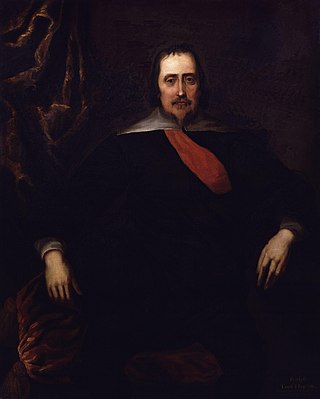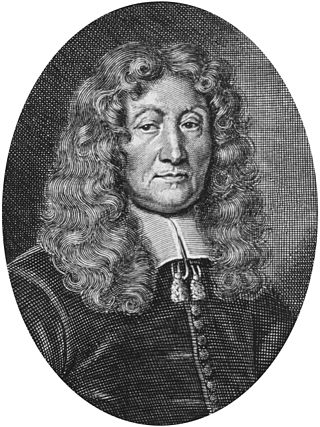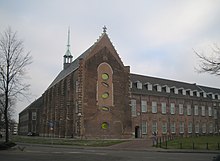History
Breda was the seat in the Netherlands of the House of Orange-Nassau, although the city was several times lost to the Spanish. At the Siege of Breda of 1637 the city was finally recaptured by Frederick Henry, Prince of Orange, and in 1646 he founded the college, modelling it on Saumur, Geneva, and Oxford, to train young men of good family for the army and the civil service. [1] As its home he provided the Kloosterkazerne, previously a nunnery. [2] Jan van Vliet travelled to Breda, taking his whole family with him, to be present at the inauguration of the college on 16 September 1646. [3] André Rivet, the learned French Huguenot tutor of the future William II of Orange, was the first Rector of the college. [4]
At the time the college was founded, Breda was a town of only about 4,000 inhabitants, not counting the soldiers. [5] Six months after its establishment, the college had fewer than sixty students, and its level and status were still unclear. [4] In the event, it proved to be "a general training-centre for young men of quality, many of whom were to be officers or already held that rank in the Prince's army". However, a high proportion of those taught were French Huguenots and English expatriates. [6]
Christiaan Huygens was admitted in March 1647 to study law, transferring from Leiden, and proved to be the most brilliant of Breda's students. [7] His younger brother Lodewijck Huygens was at the college from 1649 to 1651, when he got into trouble over fighting a duel. Almost immediately he was sent on a diplomatic mission to England. The brothers' father, Constantijn Huygens, was one of the "curators" (or trustees) of the college. [1]
The Englishman John Pell was professor of mathematics at the college from 1646, having been lured away from Amsterdam by Frederick Henry's offer of a salary of one thousand guilders a year. [8] He returned to England shortly before the First Anglo-Dutch War broke out in 1652. [9] Lodewijck Gerarduszoon van Renesse (1599–1671) was professor of divinity, and Franc Plant taught Hebrew. [10]
The number of students increased after 1649, when the future Charles II of England, in exile thanks to the English Civil War, settled at Breda, and the town became a haven for many of the English royalists and their families who had also been forced to flee. [5] In August 1653, Charles's secretary Sir Edward Nicholas asked Mary, Princess Royal and Princess of Orange, to use her influence to get his friend Peter Mews a post at the college as reader in philosophy, but he had a reply from Hyde that the place called for a man "that hath not bene a truant from his bookes". [11]
By the Declaration of Breda of April 1660, Charles II offered terms for a settlement which would restore him to the thrones of England, Ireland, and Scotland. On 8 May he was proclaimed king at Westminster and returned home, taking with him most of the exiles. [12] This was one of the factors which led to the college closing in 1669, [4] as by then it had too few students. [13]
After the Restoration Pell maintained a friendship with his former student at Breda William Brereton, and after Brereton died in 1680 John Aubrey wrote "Never was there greater love between Master and Scholar then between Dr. Pell and this Scholar of his, whose death hath deprived this worthy Doctor of an ingeniose Companion and a usefull Friend." [14]

Christiaan Huygens, Lord of Zeelhem, was a Dutch mathematician, physicist, engineer, astronomer, and inventor who is regarded as a key figure in the Scientific Revolution. In physics, Huygens made seminal contributions to optics and mechanics, while as an astronomer he studied the rings of Saturn and discovered its largest moon, Titan. As an engineer and inventor, he improved the design of telescopes and invented the pendulum clock, the most accurate timekeeper for almost 300 years. A talented mathematician and physicist, his works contain the first idealization of a physical problem by a set of mathematical parameters, and the first mathematical and mechanistic explanation of an unobservable physical phenomenon.

Sir Constantijn Huygens, Lord of Zuilichem, was a Dutch Golden Age poet and composer. He was also secretary to two Princes of Orange: Frederick Henry and William II, and the father of the scientist Christiaan Huygens.

Ralph Hopton, 1st Baron Hopton was an English politician, military officer and peer. During the First English Civil War, he served as Royalist commander in the West Country, and was made Baron Hopton of Stratton in 1643.

Frederick Henry was the sovereign prince of Orange and stadtholder of Holland, Zeeland, Utrecht, Guelders, Overijssel in the Dutch Republic from 1625 until his death in 1647. In the last seven years of his life, he was also the stadtholder of Groningen (1640-1647).

Amalia of Solms-Braunfels was Princess of Orange by marriage to Frederick Henry, Prince of Orange. She acted as the political adviser of her spouse during his reign, and acted as his de facto deputy and regent during his infirmity from 1640 to 1647. She also served as chair of the regency council during the minority of her grandson William III, Prince of Orange from 1650 until 1672.

Mary, Princess Royal, was an English princess, a member of the House of Stuart, and by marriage Princess of Orange and Countess of Nassau. She acted as regent for her minor son from 1651 to 1660. She was the first holder of the title Princess Royal.

John Pell was an English mathematician and political agent abroad.

Breda is a city and municipality in the southern part of the Netherlands, located in the province of North Brabant. The name derived from brede Aa and refers to the confluence of the rivers Mark and Aa. Breda has 185,072 inhabitants on 13 September 2022 and is part of the Brabantse Stedenrij; it is the ninth largest city/municipality in the country, and the third largest in North Brabant after Eindhoven and Tilburg. It is equidistant between Rotterdam and Antwerp.

The Treaty of Breda (1650) was signed on 1 May 1650 between Charles II, exiled king of England, Scotland and Ireland, and the Scottish Covenanter government. Under its terms, they agreed to install Charles II as King of Scotland and Britain, while Charles undertook to establish a Presbyterian Church of England, and guarantee the rights of the Church of Scotland.

Lieutenant-General Michael Jones, c. 1606 to 10 December 1649, was an Irish-born soldier of Welsh descent who fought for Parliament and the Commonwealth in the War of the Three Kingdoms, primarily in Ireland. Third son of Lewis Jones, Bishop of Killaloe, his brothers Henry and Ambrose were also bishops in the Protestant Church of Ireland.

Peter Mews was an English Royalist theologian and bishop. He was a captain captured at Naseby and he later had discussions in Scotland for the Royalist cause. Later made a Bishop he would report on non-conformist families.

Adriaen Hanneman was a Dutch Golden Age painter best known for his portraits of the exiled British royal court. His style was strongly influenced by his contemporary, Anthony van Dyck.

André Rivet was a French Huguenot theologian.

Samuel Bolton was an English clergyman and scholar, a member of the Westminster Assembly and Master of Christ's College, Cambridge.

Lodewijck Huygens was a Dutch diplomat.

William Walwyn was an English pamphleteer, a Leveller and a medical practitioner.
William Brereton, 3rd Baron Brereton FRS was an English mathematician and politician who sat in the House of Commons in 1659 and became Baron Brereton in the Irish peerage in 1664. He was chairman of the Committee of Accounts, better known as the Brooke House Committee, in 1667–1670. In that capacity he clashed repeatedly with Samuel Pepys, whose description of Brereton in his Second Diary, or Brooke House Journal, although no doubt biased, is the best portrait we have of the man.

John Hall (1627–1656), also known as John Hall of Durham, was an English poet, essayist and pamphleteer of the Commonwealth period. After a short period of adulation at university, he became a writer in the Parliamentary cause and Hartlib Circle member.





















